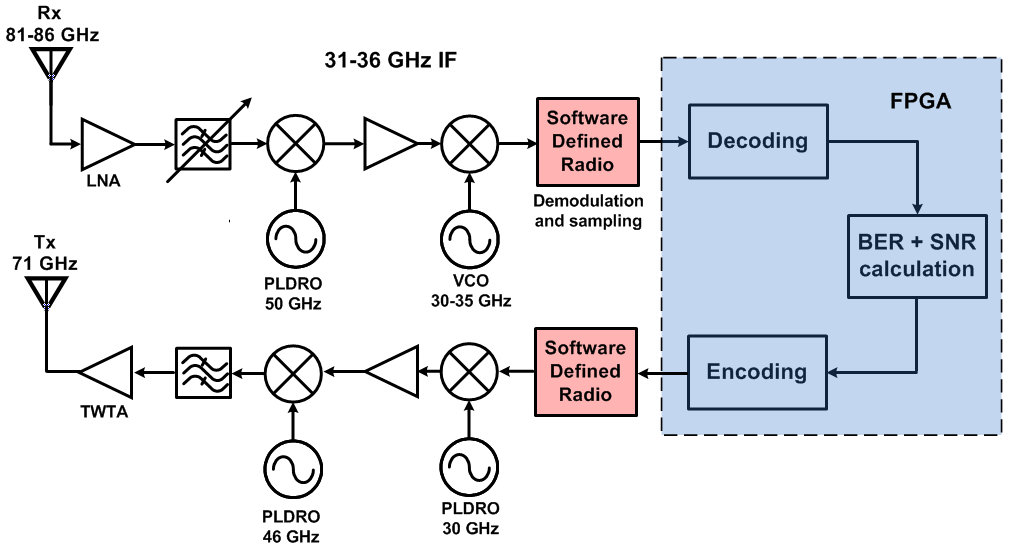Transponder Design
Figure 1. Preliminary block diagram of the transponder payload (click to enlarge)
The block diagram of the proposed transponder is shown in Figure 1. This design is based primarily on a combination of ideas presented in [1,2, 3 ].
Assumptions:
Two assumptions are made here that allowed us to propose this design for W-band operation. Firstly, it is assumed that only one of the three Earth stations is transmitting at any given time. The details of this kind of coordination will be worked out during Phase 1. Secondly, for the uplink transmission that allows three frequency tones (81 GHz, 84.5 GHz and 86 GHz), we assume that signal is transmitted using a single frequency at a time.
Design details:
The signal transmitted on the uplink using one of the three possible frequencies is received by the satellite antenna and then passed on to an LNA. This will be a room-temperature InP HEMT LNA similar to those used in both the beacon and transponder Earth station receivers. The signal from the LNA then passes through a filter and then on to two stages of down conversion. The first stage uses a 50 GHz phase-locked dielectric resonant oscillator (PLDRO) to bring the 81-86 GHz signals down to an IF of 31-36 GHz. The second stage of downconversion uses a Voltage Controlled Oscillator (VCO) which varies between 30-35 GHz to bring down the signals down to 1 GHz range. A software defined radio is proposed to be used to perform the demodulation to bring signals down to baseband and to perform the analog-to-digital conversion. A software defined radio allows for the modulation or de-modulation of a signal using a wide variety of modulation schemes. This of flexibility is very useful for experimentation purposes [3]. The digital data from the software defined radio is passed on to the FPGA which is capable of encoding/decoding, de-multiplexing and measuring the BER. A space grade FPGAs such as Xilinx Virtev-4QV will be used for this purpose as discussed in [1].
The digital signal from the Software defined radio is passed on to the FPGA which then decodes the signal by performing the FEC, calculates BER, corrects the signal and re-encodes the signal using FEC and passes it on to the software defined radio to prepare the analog signal for downlink transmission. This signal then undergoes two stages of upconversion to get to the downlink frequency of 71 GHz and is then amplified by a PA. A travelling wave tube amplifier is proposed to be used instead of solid state devices due to their capability of producing high output powers around 100 W (see Front-End Technology Selection and Downlink Budget). This amplified signal is then sent out on the downlink using the satellite transmit antenna.
References:
[1] L. Scucchia, M. Lucente, M. Ruggieri, P. Cambriani, T. Rossi, A. Bosisio, A. Pisano, A. Salome, L. Ronzitti, M. Musso, A. Iera, S. Pulitano, S. Morosi, V. Danielli and V. Speziale, “The Wave mission Payload,” IEEE Aerospace Conference, 2005.
[2] M. Ruggieri, S. De Fina, M. pratesi, E. Saggese and C. Bonifazi,”The W- Band Data Collection Experiment of the DAVID, ” IEEE Transactions on Aerospace and Electronic Systems, October 2002, Vol. 38, No.4.
[3] M. Lucente, T. Rossi, C. Stallo, D. Valente, M. Ruggieri, V. Dainelli and L. Ricci, “Preliminary design of a propagation experiment of a radio link analysis at W band,” IEEE GLOBECOM workshops, 2008.

